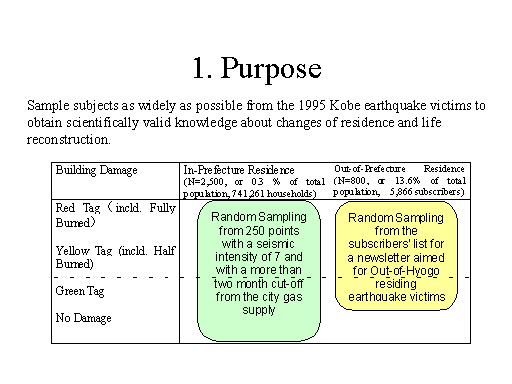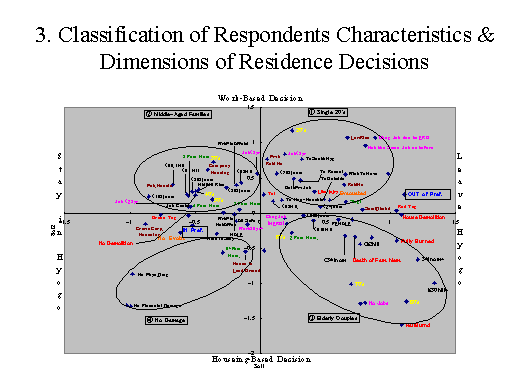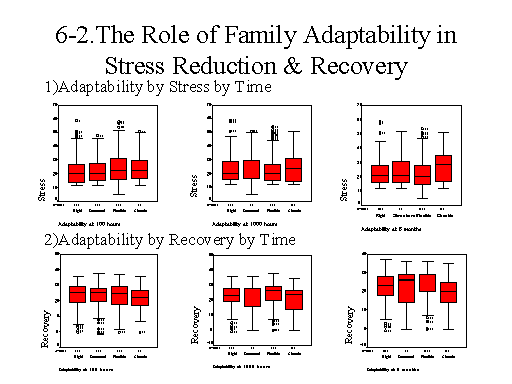Determinants of the Changes of Residence
and Life Reconstruction among the 1995 Kobe
Earthquake Victims�
99/07/12
Shigeo TATSUKI & Haruo HAYASHI (1999).
 A random sample mail survey was conducted
on 3,300 earthquake victims who experienced
severe life difficulties due to the 1995
Kobe earthquake. The sample consisted of
two groups. One group consisted of those
who stayed within Hyogo prefecture: 2,500
In-Hyogo residents were sampled from 250
randomly selected points with a seismic intensity
of 7 and with a more than two month cut-off
from the city gas supply. The other group
consisted of those who left Hyogo prefecture:
800 Out-of-Hyogo residents were randomly
selected from the subscribers' list for a
Hyogo Government newsletter aimed for Out-of-Hyogo
residing earthquake victims.
A random sample mail survey was conducted
on 3,300 earthquake victims who experienced
severe life difficulties due to the 1995
Kobe earthquake. The sample consisted of
two groups. One group consisted of those
who stayed within Hyogo prefecture: 2,500
In-Hyogo residents were sampled from 250
randomly selected points with a seismic intensity
of 7 and with a more than two month cut-off
from the city gas supply. The other group
consisted of those who left Hyogo prefecture:
800 Out-of-Hyogo residents were randomly
selected from the subscribers' list for a
Hyogo Government newsletter aimed for Out-of-Hyogo
residing earthquake victims.
 993 (683 In-Hyogo and 313 Out-of-Hyogo) questionnaires
were returned and responses from 623 In-Hyogo
(25.7%) and 292 Out-of-Hyogo residents (37.1%)
were valid. Based on findings from preceding
ethnographic research, the questionnaire
was designed to inquire about residence location,
source of help, family cohesion and adaptability
at the 10th, 100th, and 1000th hour as well as at the six months after the
onset of the earthquake. These time points
were found to correspond with critical boundaries,
which segmented phases of the disaster victims'
behavior.
993 (683 In-Hyogo and 313 Out-of-Hyogo) questionnaires
were returned and responses from 623 In-Hyogo
(25.7%) and 292 Out-of-Hyogo residents (37.1%)
were valid. Based on findings from preceding
ethnographic research, the questionnaire
was designed to inquire about residence location,
source of help, family cohesion and adaptability
at the 10th, 100th, and 1000th hour as well as at the six months after the
onset of the earthquake. These time points
were found to correspond with critical boundaries,
which segmented phases of the disaster victims'
behavior.
These were some of the major findings. 1)
Patterns of residence location change were
drastically different between those with
severe house damage and with light damage. About 80% of those who lost houses evacuated
to shelters at the 10th hour, and about the same number of victims
continued to stay at the evacuation shelters
at the 100th hour, and at temporary dwellings at the
1000th hour as well as at the 6th month after the earthquake. In comparison,
only 24 % of those whose houses were lightly
damaged evacuated at the 10th and 100th hour, but the number declined to 14% at
the 1000th hour and it declined further to 10 % at
6 months after the earthquake. A pattern
of residence change among In-Hyogo residents
resembled that of those with light house
damage, while the patterns of Out-of-Hyogo
residents were quite similar to those with
heavy house damage.
About 80% of those who lost houses evacuated
to shelters at the 10th hour, and about the same number of victims
continued to stay at the evacuation shelters
at the 100th hour, and at temporary dwellings at the
1000th hour as well as at the 6th month after the earthquake. In comparison,
only 24 % of those whose houses were lightly
damaged evacuated at the 10th and 100th hour, but the number declined to 14% at
the 1000th hour and it declined further to 10 % at
6 months after the earthquake. A pattern
of residence change among In-Hyogo residents
resembled that of those with light house
damage, while the patterns of Out-of-Hyogo
residents were quite similar to those with
heavy house damage.



 2) Bipolar decisions, namely job-based and
housing-based, dictated whether one should
stay or leave Hyogo prefecture. Elderly inner-city
dwelling couples who lost houses were pushed
out of Hyogo prefecture by housing based
decisions. They were characterized by those
who used to occupy and lost their own wooden
tenement houses on leased land following
the earthquake or the consequent fire. People
in their 20's with less than 3 years seniority
lost employment and were pulled out of Hyogo
prefecture. In comparison, those who kept
their jobs and those in their 30's, 40's
and 50's with three to five family members
tended to stay in Hyogo prefecture. Their
decision to stay seemed to be job based.
Finally, those who did not experience any
severe house damage also stayed. This decision
to stay seemed to be housing-based.
2) Bipolar decisions, namely job-based and
housing-based, dictated whether one should
stay or leave Hyogo prefecture. Elderly inner-city
dwelling couples who lost houses were pushed
out of Hyogo prefecture by housing based
decisions. They were characterized by those
who used to occupy and lost their own wooden
tenement houses on leased land following
the earthquake or the consequent fire. People
in their 20's with less than 3 years seniority
lost employment and were pulled out of Hyogo
prefecture. In comparison, those who kept
their jobs and those in their 30's, 40's
and 50's with three to five family members
tended to stay in Hyogo prefecture. Their
decision to stay seemed to be job based.
Finally, those who did not experience any
severe house damage also stayed. This decision
to stay seemed to be housing-based.
3) Asking kith and kin for temporary dwelling
peaked at the 100th hour period, but it declined hereafter.
Meanwhile, housing help from the workplace
became more prevalent among In-Hyogo residents
at the 1,000th hour point. On the other hand, the most
prevalent types of dwelling for Out-of-Hyogo
residents after the 1,000th hour were temporary rental housing which
was financed at the evacuee's own expense.
It should be noted that a strikingly small
proportion of victims (1.3 % In- and 2.1
% of Out-of-Hyogo residents) opted for publicly
supplied temporary housing units 6 months
after the earthquake.
 4) A need for information regarding livability
and house repair options peaked at the first
one week after the earthquake and nearly
half of the victims made up their minds with
regard to dwelling options within one month
after the earthquake. Furthermore, those
whose houses received seemingly light damage
showed the highest need for information regarding
livability and house repair options during
the first week after the earthquake.
4) A need for information regarding livability
and house repair options peaked at the first
one week after the earthquake and nearly
half of the victims made up their minds with
regard to dwelling options within one month
after the earthquake. Furthermore, those
whose houses received seemingly light damage
showed the highest need for information regarding
livability and house repair options during
the first week after the earthquake.
 5) Those whose family cohesion level increased
to a high level at the 100th hour but did not maintain such a high cohesion
level at the 1000th hour tend to show better adjustment at present.
Similarly, the families that showed a clear
leadership structure at the 100th hour but later increased the level of flexibility
six months after the earthquake tended to
be better adjusted than other families.
5) Those whose family cohesion level increased
to a high level at the 100th hour but did not maintain such a high cohesion
level at the 1000th hour tend to show better adjustment at present.
Similarly, the families that showed a clear
leadership structure at the 100th hour but later increased the level of flexibility
six months after the earthquake tended to
be better adjusted than other families.

6) Reflection on pre- to post-earthquake
changes in civic-mindedness revealed that
self-governance and a solidarity orientation
increased while conformity/obedience to preexisting
morality decreased. Furthermore, those who
are high on the self-governance and solidarity
formation orientation scale tended to be
better-adjusted four years after the earthquake
than those who were low.

URL:http://www-soc.kwansei.ac.jp/tatsuki/papers/NaturalHazardWorkshop/PosterSession&RoundTable1999/index.htm
All Rights Reserved. COPYRIGHT(C) 1998-99,
Shigeo TATSUKI










